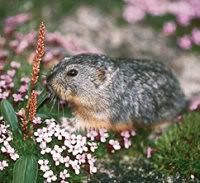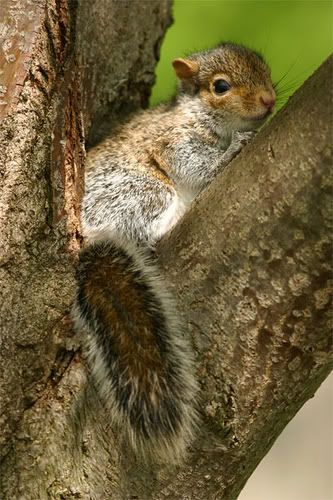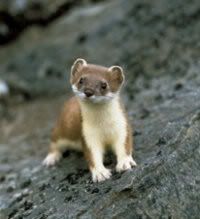Lemmings don't jump off cliffs!
I don't consider lemmings particularly cute as rodents go, but they can be comparatively interesting. Lemmings are most famous for their alleged tendency to commit mass suicide by jumping off cliffs when their numbers become too great. (I've heard that this myth originated with a Disney film, but that could be a myth too.)
In any case, this article discusses an alternate, more plausible, explanation for the dramatic population swings that really do occur.
First, the obligatory picture of a lemming (from the article):

. . . and, for no particular reason, a picture of a much cuter baby squirrel (from this site):

Now for the article (written October 31, 2003) . . . Here is an edited version:
"One of the oddest phenomena in the natural world - the sudden mass death of lemmings - has been resolved, according to a trio of European biologists.
Olivier Gilg of the University of Helsinki in Finland and colleagues publish their research in today's issue of the journal Science.
[. . .]
Lemming populations, [the researchers] say, surge spectacularly and fall just as quickly, thanks to the combined feasting of four predators: the stoat, arctic fox, snowy owl and a seabird called the long-tailed skua.
The researchers [. . .] found that the population of lemmings and their cousins, the vole, can explode by 100 or even 1,000 times their original size.
That, in turn, boosts the predator numbers, which become so numerous and gorge so much on the lemmings that the rodent numbers plummet dramatically. The next phase is that the lack of lemming drives down the predator numbers.
[. . .] what is interesting in this case is that, with the lemmings, the pattern is almost like clockwork. It is a four-year 'boom and bust' cycle whose key is the stoat, a specialist predator whose only source of food is the lemming. The three other predators are 'generalists' - they like to tuck into lemmings but also have alternative nutrition.
The statistical clue to understanding the cycle is stoat numbers, which take a delay of about a year before falling in response to a lemming crash. The 'generalist' predators are still affected by a fall in lemming numbers but their population decline takes longer to kick in because they can immediately find other food when the crash takes effect."
In short, the reason for the lemmings' dramatic population swings is that — under the right conditions — the lemmings multiply rapidly. Their abundance leads to more predators, who feast on the poor little rodents. Then, when the feasting has wiped out vast numbers of lemmings, many predators run out of food, and their numbers drop. Some time later, the cycle repeats.
It all seems rather dramatic and stressful. I think that, if I were a lemming, I would prefer more steady, balanced arrangements. :o)
Anyway, I will leave you with this picture (also from the article) of a stoat ("key to the boom bust cycle of lemmings"):


1 Comments:
"One of the oddest phenomena in the natural world - the sudden mass death of lemmings..." Either the natural world has lost all it's phenomenas, or this is the biased line of lemming-researchers. Come now, there have to be odder things than that! :-)
Post a Comment
<< Home